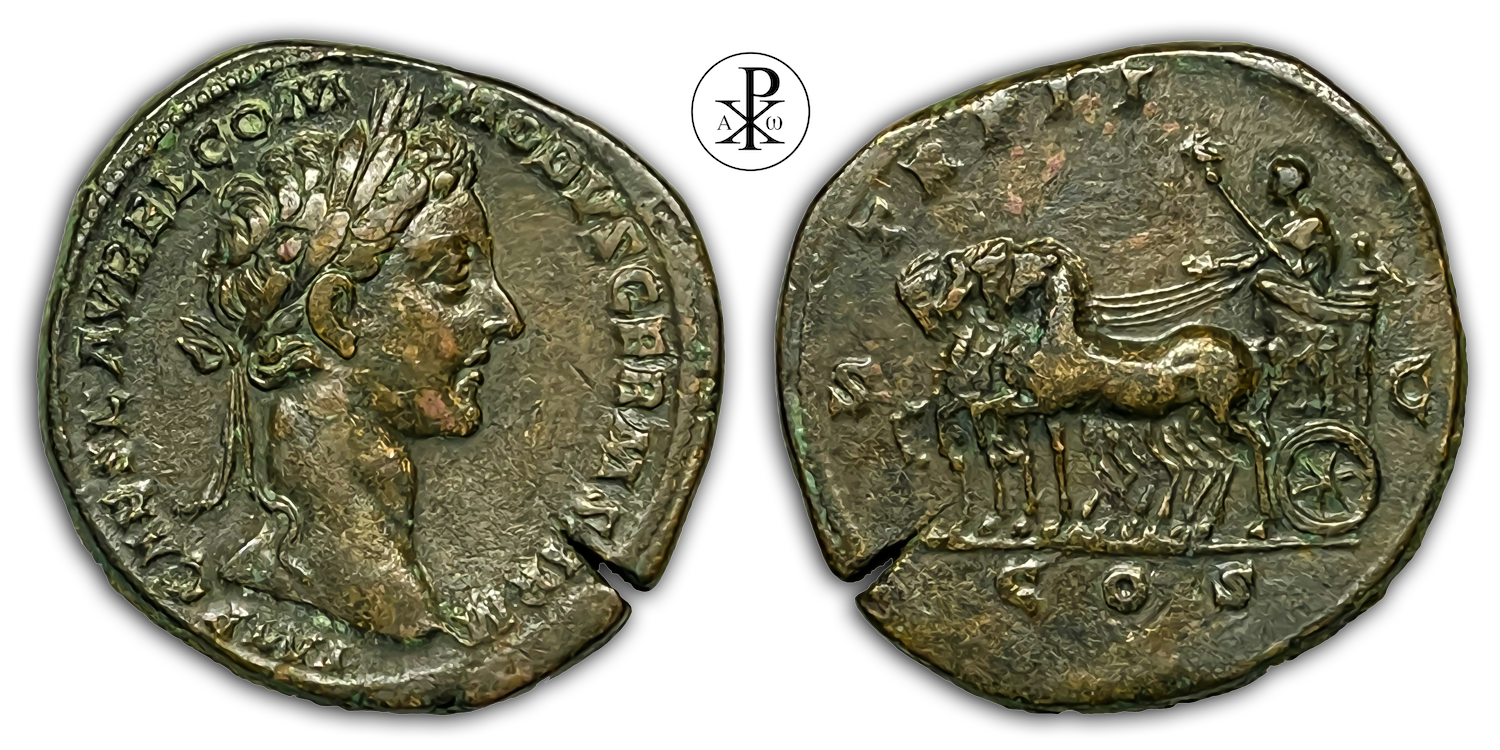Lucius Aurelius Commodus Caesar Augusti Filius
Reign: Marcus Aurelius
Mint: Rome
Date: 177 AD
Nominal: Sestertius
Material: AE Bronze
Diameter: 33mm
Weight: 27.43g
Reference: RIC III Marcus Aurelius 1564 var. (only laureate)
Reference: Banti 410 („A. Hess 1933“)
Reference: MIR 382-16/30 („Schulman, Amsterdam, Juni 1924, 862“, same picture as Banti/Hess)
OCRE Online: http://numismatics.org/ocre/id/ric.3.m_aur.1564
Schulmann Online #1: https://gallica.bnf.fr/ark:/12148/bpt6k30434764/f70.item
Schulmann Online #2: https://gallica.bnf.fr/ark:/12148/bpt6k30434764/f127.item
Rare: R3
Provenance: Carthago Numismatics Ile de France, France
Pedigree: –
Special: 2nd known example, Variation only laureate
Obverse: Head of Commodus, laureate, right
Inscription: IMP CAES L AVREL COMMODVS GERM SARM
Translation: Imperator, Caesar, Lucius Aurelius Commodus, Germanicus, Sarmaticus
Translation: Imperator, Caesar, Lucius Aurelius Commodus, conqueror of the Germans, conqueror of the Sarmatians
Reverse: Commodus, in quadriga, moving left, holding eagle-tipped sceptre in right hand
Inscription: TR P II COS S C
Translation: Tribunicia Potestate Secunda, Consul, Senatus Consultum
Translation: Holder of tribunician power for the second time, consul. Decree of the senate
Comment: This generally rare quadriga sestertius type (RIC 1563, RIC 1564, Cohen 749) was minted and issued only over a very short period. The second „Tribunicia Potestate“ was awarded to Commodus on 10 December 176 AD, he took up the first consulship together with M. Plautius Quintillus on 01 January 177 AD. This is the earliest possible date of issue. In the middle of 177 AD Commodus received the title Augustus and pater patriae and was thus elevated to the equal co-emperor of his father. From this time onwards Commodus now called himself on coins L. Commodus Aug. cos. p. p. (Cohen 63. 66. 67) or L. Aurelius. Commodus Aug. cos. p. p. (Cohen 65. 68. 743) or Imp. L. Aurelius. Commodus Aug. Germ. Sarm. tr. p. II cos. p. p. (Cohen 79. 80. 83-90. 95. 96. 98-102. 744-748) or finally Imp. Caes. L. Aurelius. Commodus Aug. Germ. Sarm. tr. p. II cos. p. p. (Cohen 91). The short minting period of this sestertius type can thus be narrowed down between January and about mid-177 AD.
The reverse has an interesting historical background. In the spring of 175 AD Commodus set off to join his father in Germania. Marcus Aurelius then declared him of age on 7 July 175 AD and recommended him to the soldiers. After the end of the First Marcomannic War (there was a truce with the Jazygians; they surrendered 100,000 Roman prisoners and provided a contingent of 8000 horsemen, 5500 of whom were detached to Britain) Commodus travelled with his father to Syria and Egypt in 175-176 AD; from which they both then returned to Rome in the autumn of 176 AD. After their return, Marcus Aurelius – and later his son Commodus – celebrated a triumph („de Germanis“ and „de Sarmatis“) in Rome on 23 December of 176 AD. The triumphal procession of Commodus is said to have been deliberately held later and separately from his father in order to present the potential heir to the throne to the Roman people separately. Marcus Aurelius walked alongside his son’s triumphal chariot (Marc. 16, 2). Since the triumphal procession is said to have taken place about a month after that of Marcus Aurelius – the event (which the sestertius presented here depicts) can be assumed to have taken place around mid to late January 177 AD.
It seems that three variations of this type of sestertius exist. The reference RIC 1563 speaks of „Head of Commodus, bare, right“. However, there is no example image of this variant in RIC itself. Nor have I found any other examples of this variant – not on the internet, a past auction, a museum, a catalogue or any other reference. Cohen and Sear do not know this variant at all, so it is questionable whether this type exists at all. The reference RIC 1564 knows two variations (which is also known by Cohen with Commodus 749) with „Bust of Commodus, laureate, right“ and „Bust of Commodus, laureate, draped, cuirassed, right“. The latter variant is also illustrated at RIC itself (Münzkabinett der Universität Göttingen). I have also found an illustrated example from the University of Oxford (HCR22883) and an example from a private collector on the internet. The variant „laureate, draped, cuirassed, right“ is nevertheless extremely rare to find.
The sestertius presented here, was actually the 2nd known example. The 1st example you can find at Banti 410 („A. Hess 1933“). The coin at MIR 382-16/30 („Schulman, Amsterdam, Juni 1924, 862“) was the same as the Banti coin (same picture).
